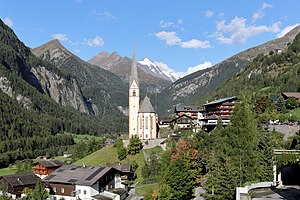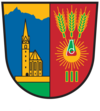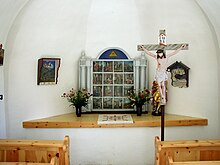Heiligenblut am Großglockner
|
Heiligenblut am Großglockner
|
||
|---|---|---|
| coat of arms | Austria map | |
|
|
||
| Basic data | ||
| Country: | Austria | |
| State : | Carinthia | |
| Political District : | Spittal an der Drau | |
| License plate : | SP | |
| Main town : | Heiligenblut | |
| Surface: | 193.15 km² | |
| Coordinates : | 47 ° 2 ' N , 12 ° 50' E | |
| Height : | 1288 m above sea level A. | |
| Residents : | 997 (January 1, 2020) | |
| Population density : | 5.2 inhabitants per km² | |
| Postal code : | 9844 | |
| Area code : | 0 48 24 | |
| Community code : | 2 06 10 | |
| NUTS region | AT212 | |
| Address of the municipal administration: |
Hof 4 9844 Heiligenblut |
|
| Website: | ||
| politics | ||
| Mayor : | Josef Schachner (HBL) | |
|
Municipal Council : ( 2015 ) (15 members) |
||
| Location of Heiligenblut am Großglockner in the Spittal an der Drau district | ||
 Heiligenblut from above |
||
| Source: Municipal data from Statistics Austria | ||
Heiligenblut am Großglockner is an Austrian municipality with 997 inhabitants (as of January 1, 2020) in the Spittal an der Drau district in Carinthia .
Heiligenblut is a high alpine village and is often visited as a starting point for visiting the Pasterze and for climbing the Großglockner . Heiligenblut is the starting point of the Grossglockner High Alpine Road .
geography
Heiligenblut is located at an average of 1288 m above sea level at the foot of the Großglockner ( 3798 m ) at the top of the Möll valley in the Hohe Tauern National Park . The Fleißtal is located near Heiligenblut .
Community structure
Heiligenblut is divided into the cadastral communities Apriach, Rojach as well as Zlapp and Hof. In addition to Heiligenblut, the municipality includes the following localities , each qualified as a village (population in brackets as of January 1, 2020):
- Aichhorn (35)
- April (122)
- Hard work (40)
- Hadergasse (57)
- Courtyard (151)
- Pockhorn (106)
- Rojach (136)
- (Under) chessing (67)
- Untertauern (74)
- Winkl (181)
- Wolkersdorf (28)
- Zlapp
Neighboring communities
|
(both Bez. Zell a.See , Sbg. ) |
Fusch adGlstr. ( Bez. Zell a.See , Sbg. ) |
Rauris ( District Zell a.See , Sbg. ) |
| Kals a. G. ( District Lienz , Tir. ) |

|
|
| Nußdorf-Debant ( District Lienz , Tir. ) | Großkirchheim |
history
According to legend, the name "Heiligenblut" comes from a vial with the blood of Christ , which Briccius (also Briktius , Brictius , Latin for Friedrich ), a Danish prince, was buried here by an avalanche on his way back from Constantinople around 914 , in the calf to protect it from predators. From the masses of snow under which he was buried, three ears of corn grew out, whereby his body and the blood relic were found. When some farmers tried to bury him, one leg stubbornly refused to stay underground. When the matter was investigated, the small bottle was found, which has since been kept in the sacrament house of the parish church of St. Vincent, which was built between 1460 and 1491. A request from the community of Heiligenblut to canonize Briccius was never approved for lack of evidence, which did not prevent the community from building its own crypt and an altar.
In addition to the predominant agriculture and alpine farming, gold was mined in Heiligenblut until the 20th century.
The high mountain region around Heiligenblut developed from the end of the 19th century into a classic summer resort and from the 1930s into a two-season tourist region. The Großglockner High Alpine Road , opened in 1935 and whose southern starting point is Heiligenblut, played a decisive role in this . Around the mountains Schareck ( 2606 m ) and Gjaidtroghöhe ( 2989 m ) above the municipality, a high-alpine ski center with modern lifts between 1301 m above sea level was established. A. and 2900 m above sea level. A. erected.
Population development
At the time of the 2001 census, Heiligenblut had 1,185 inhabitants. 97.7% of them were Austrian and 1.1% German . Between the 1991 and 2001 censuses, the resident population decreased by 5.9% due to emigration. The emigration could not be offset by a slightly positive birth balance. Before that, the population had decreased by 5.4% since 1981. Compared to the neighboring communities, Heiligenblut shows the greatest decline in the number of inhabitants:
 Resident of Heiligenblut |
 |
Economy and Infrastructure
Economic structure
When comparing employment, Heiligenblut shows some peculiarities in comparison with the neighboring communities of Großkirchheim , Mörtschach and Winklern , which all have approximately the same number of residents: Employment in the area of "accommodation and catering" is very pronounced and the area of "transport" is also above average . Also contributes to the Grossglockner High Alpine Road PLC with 120 employees at (seven sites).
 |
 |
tourism
Tourism is a very important economic factor , which is particularly evident in comparison with the neighboring communities. However, the number of overnight stays has been falling in recent years. This is mainly due to the reduction in the average length of stay. It fell from 4.0 days in 2008 to 3.1 days in 2017. In contrast to the neighboring communities, Heiligenblut has two almost equally pronounced seasons with peaks of around 40,000 overnight stays in February and August.
 |
 |
Commute
In comparison with the other places in the upper Mölltal, Heiligenblut has the lowest number of out- commuters . The breakdown of commuters according to the distance in road kilometers shows little commuting under 30 kilometers, an initial peak at 30–39 kilometers and a clear peak in the range over 200 kilometers.
 |
 |
Infrastructure
- Road: Großglockner Straße (B 107) runs north from Lienz to Heiligenblut. The connection to the north in the state of Salzburg is the toll Grossglockner High Alpine Road. Due to the weather, it is only passable from the beginning of May to the beginning of November, which means that Heiligenblut can only be reached from the south for six months. The closest cities are Lienz (38 km) and the district capital Spittal (85 km). The state capital Klagenfurt is 157 kilometers away.
- Railway: Heiligenblut has no rail connection. The closest train stations are Lienz, Mallnitz and Spittal an der Drau.
- The Fleißalm tunnel railway , built in 1986/1987, leads in the winter half of the year with two groups of gondolas hanging from a ceiling rail (passing halfway) from Roßbach through a curved tunnel with windows to the higher-lying ski area Fleißalm. In summer the tunnel carries water.
Religions
According to the 2001 census, 95.5% of the population were Roman Catholic and 1.8% are Protestant . The proportions of other confessions are each less than 1%. 0.7% are without religious beliefs.
coat of arms
Blazon :
- Split Shield ; forward in gold over green sign foot a blue mountain (the form of the Grossglockner) and a gold, spitztürmige Church (form the Church of the Holy Blood), rear green red three golden broader ears of a golden nimbus considered by the middle of a wide-pressed small green bottle with red liquid (relic of the holy blood) protrudes into the halo.
The flag is yellow-blue with an incorporated coat of arms .
The split coat of arms shows the pilgrimage church in front of the stylized mountain backdrop of the Großglockner, behind three ears of wheat and the vial with the blood of Christ, from which a halo emanates, symbolize the legend of Briccius . The coat of arms was awarded to the municipality on December 9, 1965.
politics
The municipal council has 15 members.
- With the municipal council and mayoral elections in Carinthia in 2003, the municipal council had the following distribution: 6 ÖVP, 4 SPÖ, 3 FPÖ, and 2 others.
- With the municipal council and mayoral elections in Carinthia in 2009 , the municipal council had the following distribution: 7 HBL (Heiligenbluter list), 6 BZÖ, and 2 SPÖ.
- With the municipal council and mayoral elections in Carinthia in 2015 , the municipal council has the following distribution: 12 HBL, and 3 FBL (Free Citizen List Heiligenblut).
- mayor
- since 1997 Josef Schachner (ÖVP, HBL)
Capital of the municipality
| Heiligenblut ( village ) | |
|---|---|
| Basic data | |
| Pole. District , state | Spittal an der Drau , Carinthia |
| Pole. local community | Heiligenblut am Großglockner ( KG Zlapp and Hof ) |
| Locality | court |
| Coordinates | 47 ° 2 ′ 21 ″ N , 12 ° 50 ′ 30 ″ E |
| height | 1291 m above sea level A. |
| Building status | approx. 70 |
| Statistical identification | |
| Counting district / district | Heiligenblut (20610 000) |
 The striking church with parts of the place |
|
| Source: STAT : index of places ; BEV : GEONAM ; KAGIS | |
The main town is the village of Heiligenblut . It is located about 55 kilometers northwest of Spittal. It is located in the middle of the community, at around 1290 m above sea level. A. Height to the left above the Möll, at the southern foot of the Schareck ( 2606 m above sea level ), the local mountain that the cable car also leads up to. The Großglocknerstraße (B107) ends in the village and the Großglockner High Alpine Road begins .
It belongs to the village of Hof , which is therefore the nominal capital of the municipality , and to the cadastral municipality of Zlapp and Hof .
The place is a typical church village, and more recent. It only developed in the course of emerging tourism, especially from the construction of the High Alpine Road in the 1930s. As of 2013 there were around 70 buildings, which is almost 1 ⁄ 7 of the entire municipality.
Culture and sights
- Farbenstein castle ruins
- Catholic parish church Heiligenblut hl. Vinzenz: Located south below the town center on a slope, it is a steeply rising Gothic building from the 15th century in its current appearance . A chapel was first mentioned in a document as early as 1271; it was renewed from 1273 and completed in 1301. In the late 14th century, a new building was started, the choir was completed around 1430. In 1909/11 the church was restored and equipped with new furnishings and new windows. The high altar from 1520 shows the coronation of Mariae at a height of 11 meters. He comes from the Bolzano school, which is the successor to Michael Pacher .
- Briccius Chapel: The chapel is located west of Winkl at an altitude of 1629 m . The small rectangular building was built in 1872. Above the altar is a baroque painting with 16 depictions from the Briccius legend.
- Pockhorn branch church
- Aichhorn Chapel
- Grossglockner High Alpine Road , at 2504 m above sea level. A. one of the highest alpine passes in the Eastern Alps.
- Gold digging village Heiligenblut: The Tauern area was the most productive gold mining area in Europe from Roman times until World War II .
- Apriacher Stockmühlen
- regional customs
- The Heiligenbluter Sternsingen was included in the register of intangible cultural heritage in Austria in 2010 .
Others
In 2019, the location served as the setting for the crime scene: tree falls .
literature
- Hans Tritschel: Heiligenblut and its mountains . Austrian Library, Volume 18, ZDB -ID 2012679-7 . Hartleben, Vienna (among others) 1926, OBV .
- Maria Buhk: Heiligenblut and the Grossglockner . (Second edition). Self-published, Hamburg-Ahrensburg 1975, OBV .
- Rudolf Franz Ertl: Heiligenblut, the Glockner village. A chronicle of the community of Heiligenblut . (Second, revised and expanded edition). Self-published by the community of Heiligenblut, Heiligenblut 2007, ISBN 978-3-9501690-1-0 .
Web links
- Community website
- Tourist office website
- Entry on Heiligenblut in the Austria Forum (in the AEIOU Austria Lexicon )
- 20610 - Heiligenblut am Großglockner. Community data, Statistics Austria .
Individual evidence
- ↑ Statistics Austria: Population on January 1st, 2020 by locality (area status on January 1st, 2020) , ( CSV )
- ↑ a b Carinthia / Ferlach - Hohenthurn / 47. Heiligenblut am Großglockner . In: Austrian official calendar online . Jusline Austria (Verlag Österreich), Vienna 2002–, ZDB -ID 2126440-5 .
- ↑ Historical local dictionary, page 71. June 30, 2010, accessed on December 29, 2018 .
- ↑ Statistics Austria. January 1, 2018, accessed December 29, 2018 .
- ^ Statistics Austria, A look at the community, population development. Retrieved February 4, 2019 .
- ↑ Statistics Austria, A look at the community, employees at work. Retrieved February 4, 2019 .
- ^ Statistics Austria, A look at the community, overnight stays. Retrieved February 4, 2019 .
- ^ Statistics Austria, A look at the community, out-commuters. Retrieved February 4, 2019 .
- ^ Statistics Austria, A look at the community, commuters. Retrieved February 4, 2019 .
- ^ Salzburg WIKI, Großglockner High Alpine Road opening days. Retrieved February 4, 2019 .
- ↑ Ride on the Fleißalm tunnel railway youtube.com, rupilein1980, published March 16, 2012, accessed March 1, 2020, video 5:28, diversion at 2:45.
- ↑ Fleißalm Tunnelbahn in Heiligenblut alpinforum.com, accessed March 1, 2020
- ^ Quoted from Wilhelm Deuer: The Carinthian municipal coat of arms . Verlag des Kärntner Landesarchivs, Klagenfurt 2006, ISBN 3-900531-64-1 , p. 134
- ^ Province of Carinthia, municipal council election . March 1, 2015, accessed March 4, 2019 .
- ^ Province of Carinthia, mayoral election. 2015, accessed March 4, 2019 .
- ↑ Heiligenbluter Sternsinger ( memento of the original from February 1, 2014 in the Internet Archive ) Info: The archive link was automatically inserted and not yet checked. Please check the original and archive link according to the instructions and then remove this notice. , National Agency for Intangible Cultural Heritage, Austrian Commission for UNESCO
- ↑ crime scene. November 15, 2019, accessed November 26, 2019 .









